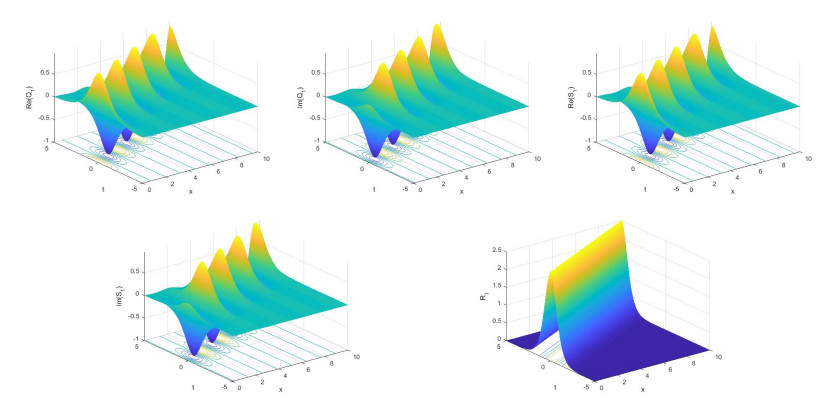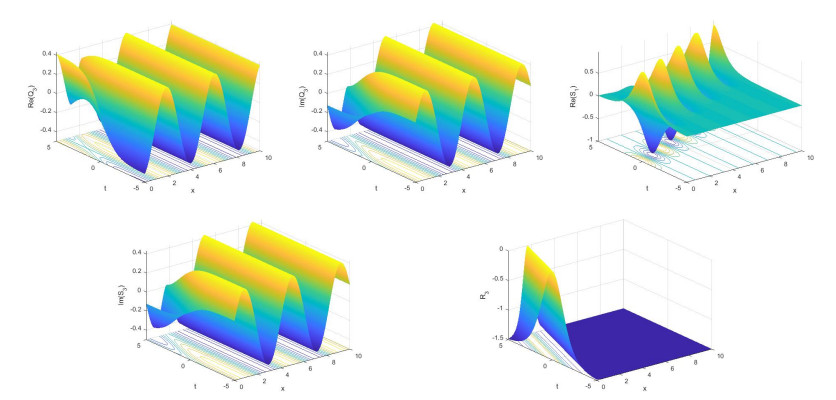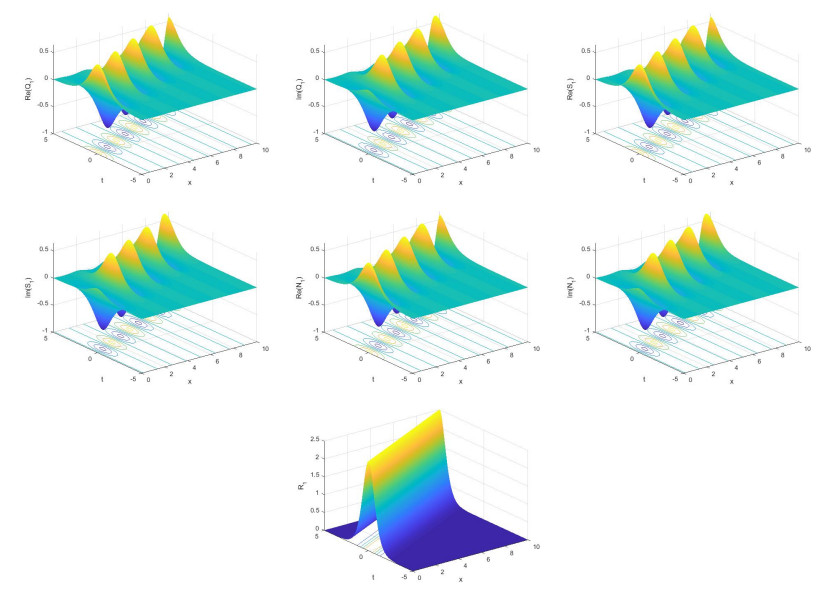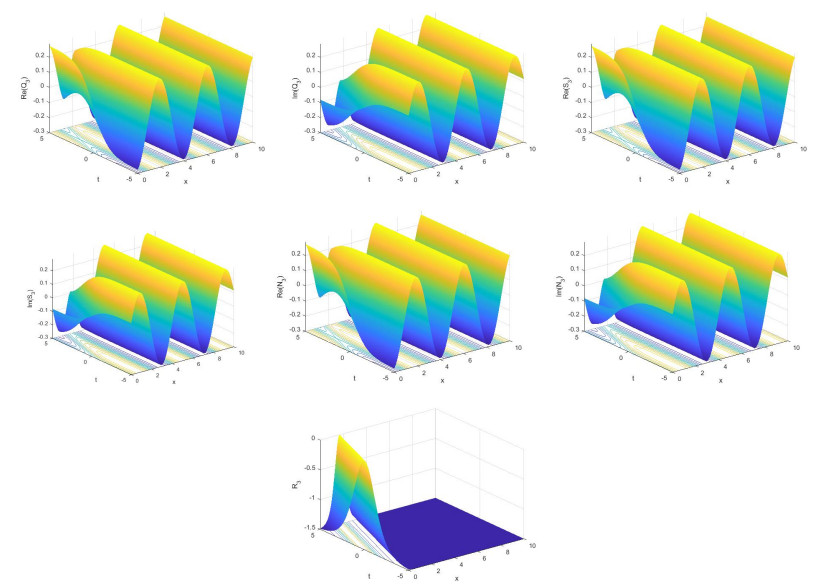1.
Introduction
Nonlinear evolution equations (NLEEs) are utilized in order to display many complex phenomena arising in various fields of applied sciences, such as superfluid, chemical engineering, thermal engineering, plasma physics, optical fibers and so on [1,2,3,4,5,6,7,8]. There are many scientists in various fields of natural sciences are interested in investigation of the nonlinear phenomena. Various vital analytical methods have been proposed and developed to extract the solutions of different kinds of NLEEs, see [9,10,11,12,13,14,15,16,17,18]. Moreover, there are recent development in studying the dynamics of soliton solutions and analytical closed-form solutions [19,20,21,22,23,24,25,26,27,28,29,30].
The Maccari (MS) system, derived by Maccari in 1996 with a reduction technique based on spatio-temporal rescaling, from the Kadomtsev-Petviashvili equation [31]. This system is a kind of NLEEs that are often introduced to prescribe the motion of the isolated waves, localized in a small part of space, in various fields such as plasma physics, quantum mechanics, Bose-Einstein condensates, optical fiber communications and so on [32,33,34,35,36,37,38,39]. Recently, some investigations presented new novel concepts in wave motions and pulses in the study of nonlinear unforeseen critical behaviors such as the electrostatic noise in auroura, the acoustics wave in fluid and telltales wiggle electric fields [40,41,42,43].
In this article, we consider the coupled MS [32,35,44], given as follows:
where Q=Q(x,y,t) denotes the complex scalar field and R=R(x,y,t) denotes the real scalar field. The independent variables are x,y and t denotes the temporal variable.
Also, we can consider the coupled nonlinear MS [45], given as follows:
where Q=Q(x,y,t) and S=S(x,y,t) denote the complex scalar fields and R=R(x,y,t) denotes the real scalar field.
Moreover, we consider the coupled nonlinear MS [34], described as follows:
where Q=Q(x,y,t), S=S(x,y,t), N=N(x,y,t) denote the complex scalar fields and R=R(x,y,t) denotes the real scalar field.
Our study is motivated to grasp some new solutions for the three coupled models of MS by using the unified solver method. This solver introduces some families of solutions in explicit way with free physical parameters. These solutions admit pivotal applications in plasma environments, superfluid, plasma physics, nonlinear optic[46,47]. The proposed solver will be utilized as a box solver for solving many other nonlinear models arising in applied science and new physics. In contrast to other methods, this solver preserves several advantages, such as, it avoids complex and tedious calculations and presents pivotal solutions in an explicit way. Moreover, this solver is simple, robust, well ordered and efficacious. The proposed solver will be significant for mathematicians, engineers and physicists. To the best of our knowledge, no previous work has been done using the proposed solver for solving the MS systems.
The present article is organized as follows. Section 2 describes the unified solver technique. Section 3 presents the solutions for three coupled of the Maccari's systems. Section 4 gives the physical interpretation of the presented results. Moreover, some graphs of some acquired solutions are depicted. Conclusions and future directions for research are all reported in Section 5.
2.
Unified solver method
We give the unified solver for the widely used NLEEs arising in the nonlinear science. For a given NLEE with some physical field Ψ(x,y,t)
we construct its explicit solutions in the form:
where k1, k2 and k3 are constants. Consequently the nonlinear evolution Eq (2.1) transformed to the following ordinary differential equation (ODE):
Based on He's semi-inverse method [48,49,50], if possible, integrate (2.3) term by term one or more times. The variational model for the differential Eq (2.3) can be obtained by the semi-inverse method [51] which reads:
where L is the Lagrangian function, of the problem described by the Eq (2.3), depending on Ψ and its derivatives given in the form:
where V is the potential function. By a Ritz method, we can find different forms of solitary wave solutions, such as Ψ(x,y,t)=α sech(βξ), Ψ(x,y,t)=α csch(βξ), Ψ(x,y,t)=α tanh(βξ), Ψ(x,y,t)=α cotch(βξ) and Ψ(x,y,t)=α sech2(βξ) where α and β are constants determined later.
We look for a solitary wave solution in the form
In this section we give the unified solver for the widely used NLEEs arising in the nonlinear science. Suppose a system of equations can be reduced to the form:
where Li,i=1,2,3 are constants. Multiplying (2.7) by Ψ′ and integrating with respect to Ψ we get the equation:
and L0 is a constant of integration. Thus the Eq (2.7) can be written in the form:
where
and V is the potential function (Sagadev potential).
We apply He's semi-inverse technique[48,49,50] for solving Eq (2.7), which construct the following variational formulation from Eq (2.8)
By Ritz-like method, we look for a solitary wave solution in the form given by Eq (2.6). Substituting from Eq (2.6) into Eq (2.11) and making J stationary with respect to α and β we obtain:
Solving simultaneously the system of equations given by (2.12) we obtain α and β. Consequently the solitary wave solution given by Eq (2.6) is well determined.
2.1. The first family
The first family of solutions takes the form:
Substituting from Eq (2.13) in Eq (2.11), we get
Since γ0 is a constant of integration we can let γ0=0 and consequently:
Making J stationary with respect to α and β leads to
Solving these equations and using (2.13), the solutions of Eq (2.9) take the form:
Consequently by using (2.10) the first family of solutions takes the form:
2.2. The second family
The second family of solutions takes the form:
The substitution from Eq (2.19) in Eq (2.11) leads to
Assuming that γ0=0 we find that
Making J stationary with respect to α and β leads to
Solving these equations and using (2.19), the second family of solutions of Eqs (2.9) and (2.7) take the form:
and
respectively.
2.3. The third family
The third family of solutions takes the form:
Substituting from Eq (2.25) into Eq (2.11), we have
Under the condition
we find that
The values of α and β which makes J stationary with respect to α and β are obtained by solving the two conditions
Solving these equations and using (2.25), the solutions of Eq (2.9) take the form:
Consequently the third family of solutions of (2.7) take the form:
3.
Applications
In this section we introduce the solutions for the coupled nonlinear Maccari's systems.
3.1. Solutions of system (1.1)
Utilizing the wave transformation:
k,α,λ and β are constants. Then the system of Eq (1.1) is converted to the following system
Integrating second equation of Eq (3.2) and taking integration constant as zero, gives
Substituting Eq (3.3) into first equation of system (3.2), yields
where
Applying the unified solver method described in Section 2, three families of solutions of Eq (1.1) are given as follows:
3.1.1. The first family of solutions
Thus,
3.1.2. The second family of solutions
Thus,
3.1.3. The third family of solutions
Thus,
3.2. Solutions of system (1.2)
Consider the wave transformation:
where k,α,λ and β are constants. By applying this transformation to the system (1.2) we get
Integrating third equation of the system of Eq (3.16) and taking integration constant as zero, gives
Substituting Eq (3.17) into first two equations of (3.16), yields
In order to solve the last system of equations, we use a simple relation between u and v, as follows:
where r is an arbitrary constant. Substituting (3.19) into the system (3.18), gives
where Γ1=1,Γ2=(1+r)22k−β,Γ3=−(λ+k2).
In view of the unified solver illustrated in Section 2 solutions of Eq (1.2) can be given in the following formulas:
3.2.1. The first family of solutions
Thus,
3.2.2. The second family of solutions
Thus,
3.2.3. The third family of solutions
Thus,
3.3. Solutions of system (1.3)
In order to solve the system of Eq (1.3), we first consider the following wave transformation:
where k,α,λ and β are constants. Substituting this transformation to system (1.3) gives
As illustrated before, we integrate the third equation of (3.37) with assuming the integration constant to be zero and this gives
Substituting Eq (3.38) into first three equation of (3.37), implies
To solve these equations, we use a simple relations between v,w and u, as follows
where r1,r2 are arbitrary constants. Substituting (3.40) into the Eq (3.39), gives
where Γ1=1,Γ2=(1+r1+r2)22k−β,Γ3=−(λ+k2).
Similarly, solutions of system (1.3) can be obtained using the unified solver, presented in Section 2, and are described in the following:
3.3.1. The first family of solutions
Thus,
3.3.2. The second family of solutions
Thus,
3.3.3. The third family of solutions
Thus,
4.
Results and discussions
Some new solutions for three coupled nonlinear Maccari's systems were achieved in explicit form. These systems are the complex nonlinear models that characteristic the dynamics of isolated waves, confined in a small part of space, in some fields such as plasma physics, superfluid and optical fiber communications [35,45]. The acquired solutions are hyperbolic function solutions. These solutions explain some interesting physical phenomena in applied science and new physics. E.g., the hyperbolic secant arises in the profile of a laminar jet whereas the hyperbolic tangent emerges in the study of magnetic moment and special relativity. Indeed, the presented solutions included bright and dark and soliton solutions of the nonlinear Maccari's systems.
According to the presented results in Section 3 we found that
1) The last model generalize the first two models.
2) There is no change in the form of the real field R(x,y,t) in the three models.
Remark 1. 1) The proposed solver in this study can be implemented for the wide classes of nonlinear stochastic partial differential equations (NSPDEs).
2) The proposed solver can be easily extended for solving nonlinear stochastic fractional partial differential equations (NSFPDEs) [52,53,54].
3) The proposed solver averts monotonous and complex computations and introduces vital solutions in an explicit form.
For certain values of the parameters in each three cases, Figures 1–6 display the nonlinear dynamical behaviour of the bright and dark soliton solutions.
5.
Conclusions
In this article, three coupled nonlinear Maccari's systems were solved using the unified solver technique. Some vital soliton solutions are presented. These solutions have vital physical aspects in many fields such as nonlinear optics plasma physics, hydrodynamic. In the view of such information, it has been seen that the unified solver method has been influential for the analytical solutions of nonlinear Maccari's systems and it is highly effective and reliable in terms of finding new solutions. Moreover, our analysis shows that the proposed solver is simple, powerful and efficient. Some graphs are presented to prescribe the dynamical behaviour of selected solutions. Finally, the used solver can be applied for so many other models emerging in natural science.
Conflict of interest
The authors declare that they have no known competing financial interests or personal relationships that could have appeared to influence the work reported in this paper.










 DownLoad:
DownLoad:








